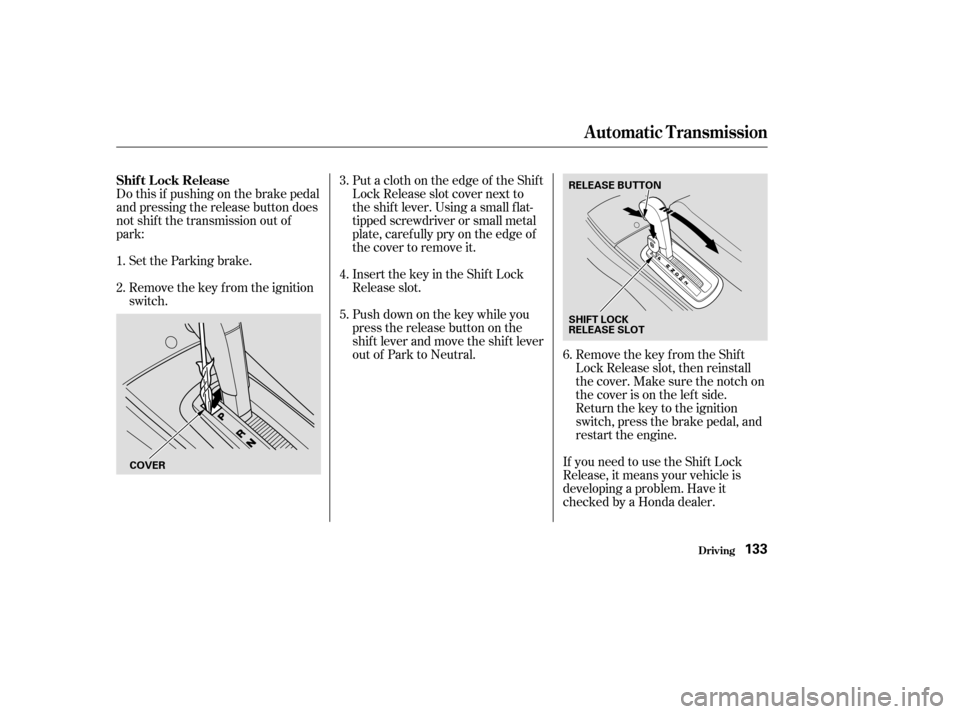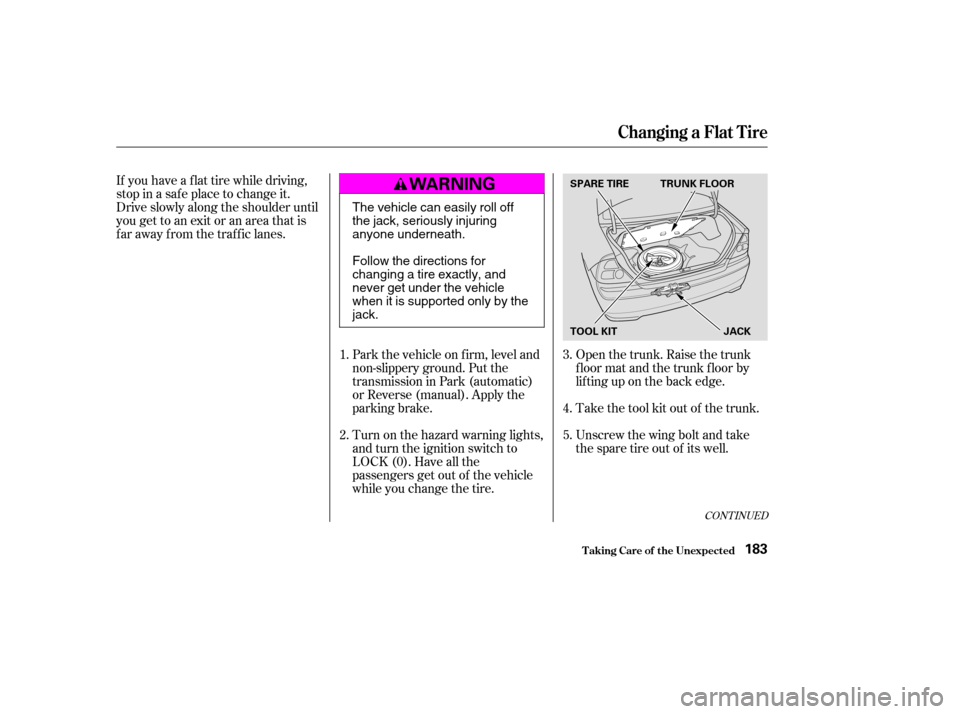Page 126 of 231

If the engine does not start within
15 seconds, or starts but stalls
right away, repeat step 4 with the
accelerator pedal pressed halfway
down. If the engine starts, release
pressure on the accelerator pedal
so the engine does not race.
If the engine fails to start, press
the accelerator pedal all the way
downandholdittherewhile
starting to clear flooding. If the
engine still does not start, return
to step 5.
Apply the parking brake.
In cold weather, turn of f all
electrical accessories to reduce
the drain on the battery.
Make sure the shif t lever is in
Park. Press on the brake pedal.
Push the clutch pedal down all the
way.
Without touching the accelerator
pedal, turn the ignition key to the
START (III) position. Do not hold
the key in START for more than
15 seconds at a time. If the engine
does not start right away, pause
f or at least 10 seconds bef ore
trying again. 5. 6.
1. 2. 3. 4.
Manual Transmission:
Automatic Transmission:
Starting the Engine
Driving127
NOTICE: The engine is harder to start
in cold weather. Also, the thinner air
f ound at altitudes above 8,000 f eet
(2,400 meters) adds to this problem.
�����—�����—�����y�
�������������y���
�(���%�������y���
�����y
Page 129 of 231
These indicators on the instrument
panel show which position the shif t
lever is in.To shif t f rom any position, press
f irmly on the brake pedal and press
the release button on the front of the
shiftlever.Youcannotshiftoutof
Park when the ignition switch is in
LOCK (0) or ACCESSORY (I).
The ‘‘D’’ indicator comes on f or a
f ew seconds when you turn the
ignition switch to ON (II). If it
f lashes while driving (in any shif t
position), it indicates a possible
problem in the transmission. Avoid
rapid acceleration and have the trans-
mission checked by a Honda dealer
as soon as possible.
Automatic Transmission
Shif t L ever Position Indicators
Shif ting
Driving130
U.S.: LX, EX, Canada: LX, Si RELEASE BUTTONSHIFT LEVER
Canada: DX
U.S.: DX
�����—�����—�����y�
���������
���y���
�(���%�������y���
�����y
Page 130 of 231

�µ
�µ �µ
�µ
�µ
To shift from: PtoR
RtoP
NtoR
Dto2
2toD
DtoD DtoN
DtoD NtoDRtoN Do this:
Press the brake pedal and
press the release button.
Press the release button.
Move the lever.
3
3
3 3
3
3
To avoid transmission damage, come
to a complete stop bef ore shif ting
into Park. The shif t lever must be in
Park bef ore you can remove the key
from the ignition switch. Press the brake
pedal and press the release button to
the f ront of shif t lever to shif t f rom
Park to Reverse. To shif t f rom
Reverse to Neutral, come to a
completestopandthenshift.
Use Neutral if you
need to restart a stalled engine, or if
it is necessary to stop brief ly with
the engine idling. Shif t to the Park
position if you need to leave your
vehicle for any reason. Press on the
brake pedal when you are moving
the shift lever from Neutral to
another gear. Use this position f or
your normal driving. The transmis-
sion automatically selects a suitable
gear f or your speed and acceleration.
You may notice the transmission
shif ting up at higher speeds when
the engine is cold. This helps the
engine warm up f aster.
This position is similar
to D, except only the first three
gears are selected. Use D to provide
engine braking when going down a
steep hill. D can also keep the
transmission f rom cycling between
third and f ourth gears in stop-and-go
driving.
This position mechani-
cally locks the transmission. Use
Park whenever you are turning of f or
starting the engine. To shif t out of
Park, you must press on the brake
pedal and have your f oot of f the
accelerator pedal.
If you have done all of the above and
still cannot move the lever out of
Park, see on
page . 133
CONT INUED
Reverse (R)
Neutral (N) Drive (D)
Drive (D )
Park (P)
Shif t L ock Release
3
Automatic Transmission
Driving131
�����—�����—�����y�
�������������y���
�(���%�������y���
�����y
Page 132 of 231

Do this if pushing on the brake pedal
and pressing the release button does
not shif t the transmission out of
park:Put a cloth on the edge of the Shif t
Lock Release slot cover next to
the shif t lever. Using a small f lat-
tipped screwdriver or small metal
plate, caref ully pry on the edge of
the cover to remove it.
Remove the key from the Shift
Lock Release slot, then reinstall
thecover.Makesurethenotchon
the cover is on the lef t side.
Return the key to the ignition
switch, press the brake pedal, and
restart the engine.
Insert the key in the Shift Lock
Release slot.
Push down on the key while you
pressthereleasebuttononthe
shif t lever and move the shif t lever
out of Park to Neutral.
If you need to use the Shif t Lock
Release, it means your vehicle is
developing a problem. Have it
checked by a Honda dealer.
Set the Parking brake.
Remove the key from the ignition
switch.
1. 2. 3. 4. 5.
6.
Automatic Transmission
Driving
Shif t L ock Release
133
COVER SHIFT LOCK
RELEASE SLOT
RELEASE BUTTON
�����—�����—�����y�
�������������y���
�(���%�������y���
�����y
Page 133 of 231
Honda’s Continuously Variable
Transmission’s unique design
provides a smooth, constant f low of
power. It is electronically controlled
f or more precise operation and
better f uel economy.These indicators on the instrument
panel show which position the shif t
lever is in.
The ‘‘D’’ indicator comes on f or a
f ew seconds when you turn the
ignition switch to ON (II). If it
f lashes while driving (in any shif t
position), it indicates a possible
problem in the transmission. Avoid
rapid acceleration and have the trans-
mission checked by a Honda dealer
as soon as possible.To shif t f rom any position, press the
releasebuttononthefrontof the
shiftlever.Youcannotshiftoutof
Park when the ignition switch is in
LOCK (0) or ACCESSORY (I).
On HX model
Automatic Transmission (CVT)
Driving
Continuously Variable
T ransmission (CVT )
Shif t L ever Position Indicators Shif ting
134
RELEASE BUTTONSHIFT LEVER
�����—�����—�����y�
�������������y���
�(���%�������y���
�����y
Page 134 of 231

�µ
�µ �µTo shift from:
PtoR
RtoP
NtoR StoL
LtoS
StoD
DtoS
DtoN
NtoD RtoN Do this:
Press the brake pedal and
press the release button.
Press the release button.
Move the lever.To shift from Re-
verse to Park, see the explanation
under Park. To shif t to Reverse f rom
Neutral, come to a complete stop
first. Press the release button before
shifting into Reverse from Neutral.
This position mechani-
cally locks the transmission. Use
Park whenever you are turning of f or
starting the engine. To shif t out of
Park, you must press on the brake
pedal and have your f oot of f the
accelerator pedal.
If you have done all of the above and
still cannot move the lever out of
Park, see on
page . To avoid transmission damage, come
to a complete stop bef ore shif ting
into Park. The shif t lever must be in
Park bef ore you can remove the key
from the ignition switch.
Use Neutral if you
need to restart a stalled engine, or if
it is necessary to stop brief ly with
the engine idling. Shif t to the Park
position if you need to leave your
vehicle for any reason. Press on the
brake pedal when you are moving
the shift lever from Neutral to
another gear.
133
CONT INUED
Automatic Transmission (CVT)
Driving
Reverse (R)
Park (P) Shif t L ock Release Neutral (N)
135
�����—�����—�����y�
�������������y���
�(���%�������y���
�����y
Page 182 of 231

Park the vehicle on f irm, level and
non-slippery ground. Put the
transmission in Park (automatic)
or Reverse (manual). Apply the
parking brake.
Turn on the hazard warning lights,
and turn the ignition switch to
LOCK (0). Have all the
passengers get out of the vehicle
while you change the tire.Take the tool kit out of the trunk.
Unscrew the wing bolt and take
the spare tire out of its well.
Open the trunk. Raise the trunk
f loor mat and the trunk f loor by
lif ting up on the back edge.
If you have a f lat tire while driving,
stop in a saf e place to change it.
Drive slowly along the shoulder until
you get to an exit or an area that is
far away from the traffic lanes.
5.
4.
3.
2.
1.
CONT INUED
Changing a Flat T ire
T aking Care of t he Unexpect ed183
SPARE TIRE TRUNK FLOOR
TOOL KIT JACK
The vehicle can easily roll off
the jack, seriously injuring
anyone underneath.
Follow the directions for
changing a tire exactly, and
never get under the vehicle
when it is supported only by thejack.
�����—�����—�����y�
�������������y���
�(���%�������y���
�����y
Page 188 of 231

Diagnosing why your engine won’t
start f alls into two areas, depending
on what you hear when you turn the
key to START (III):You hear nothing, or almost
nothing. The engine’s starter
motor does not operate at all, or
operates very slowly.
You can hear the starter motor
operating normally, or the starter
motor sounds like it is spinning
f aster than normal, but the engine
does not start up and run. Check these things:
When you turn the ignition switch to
START (III), you do not hear the
normal noise of the engine trying to
start. You may hear a clicking sound
or series of clicks, or nothing at all.
Check the transmission interlock.
If you have a manual transmission,
the clutch pedal must be pushed
all the way to the f loor or the
starter will not operate. With an
automatic transmission, it must be
in Park or Neutral.
Turn the ignition switch to ON (II).
Turn on the headlights and check
their brightness. If the headlights
are very dim or don’t light at all,
the battery is discharged. See on page . Turn the ignition switch to START
(III). If the headlights do not dim,
check the condition of the f uses. If
the f uses are OK, there is
probably something wrong with
the electrical circuit f or the
ignition switch or starter motor.
You will need a qualif ied
technician to determine the
problem (see
on page ).
If the headlights dim noticeably or
go out when you try to start the
engine, either the battery is dis-
charged or the connections are
corroded. Check the condition of
the battery and terminal connec-
tions (see page ). You can
then try jump starting the vehicle
f rom a booster battery (see page
).
191 203
178
191
If theEngineWon’tStart
Nothing Happens or the Starter
Motor Operates Very Slowly
Jump Starting Emergency T owing
T aking Care of t he Unexpect ed189
�����—�����—�����y�
�������������y���
�(���%�������y���
�����y